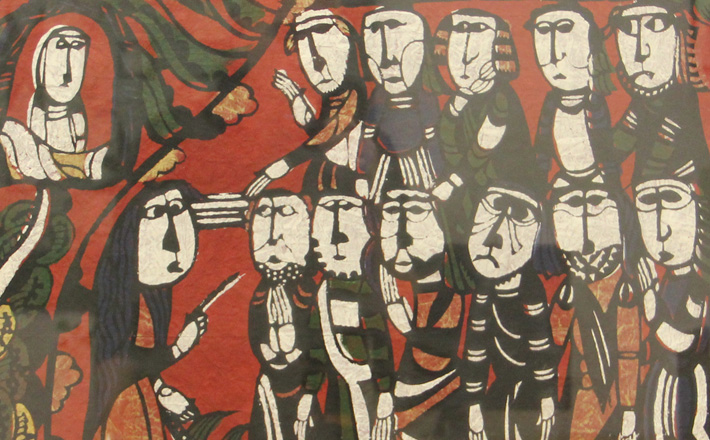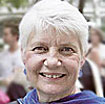Commentary on John 20:1-18
Some congregations may read John 20 at the Easter Vigil — a good choice because Mary came to the tomb “while it was still dark.”
[Looking for commentary on Luke 24:1-12? See this Easter Vigil commentary by Michael Joseph Brown.]
But many welcome this text on Easter morning for it is the most personal resurrection story. We can hear John 20 as a drama in two scenes and there are good reasons to watch the whole play, not just the last half.
Scene 1: Mary, Simon Peter, and the Other Disciple
Darkness and light are important themes in John from the prologue to Nicodemus visiting Jesus at night to Jesus’ claim, “I am the light of the world.” Mary came to the tomb while it was still dark — perhaps she simply couldn’t wait until daylight. There is no indication that she brought ointment to anoint Jesus’ body, but she knew he wasn’t alive. She had been there when he died (John 19:25). When she saw the stone rolled away she didn’t shout, “Christ is risen!” She didn’t assume resurrection, but ran to tell Simon Peter and the other disciple, “the one whom Jesus loved.” We last saw this unnamed disciple at the foot of the cross with Jesus’ mother. He is the only disciple who stayed with Jesus through the crucifixion (John 19:26-27).
The two disciples ran a foot race to the grave, the “other disciple” getting there first. Was this an attempt to diminish the stature of Peter? One of the church fathers had a more delightful explanation: “Ishodad of Merv traces John’s greater speed to the fact that he was unmarried.”1
Whatever the explanation, the other disciple looked into the tomb, but didn’t enter. Peter, panting a bit, reached the tomb and went inside. Why does John include so many details about the grave cloths and their positions? (John 20:5-7) Chrysostom was not alone in saying the reason was plain: “If anyone had removed the body, he would not have stripped it first; nor would he have taken the trouble to remove and roll up the soudarion and put it in a place by itself.”2 The soudarion was a cloth covering the face of the deceased. Lazarus came out of the tomb, “his face wrapped in a cloth” (John 11:44) With the grave cloths left behind some might wonder what Jesus was wearing if he was alive!
Simon Peter saw all these details, but gave no response. When the other disciple went in, “he saw and believed.” Is this another attempt to diminish Simon Peter? Both disciples returned home. There’s no indication that they ran to tell anybody.
As Scene One ends I think of a poem by R. S. Thomas. He was an Anglican priest whose poems are often as bleak as the Welsh landscape where he ministered. In this excerpt from his poem “The Answer” we hear a glimmer of resurrection breaking through:
… There have been times
when, after long on my knees
in a cold chancel, a stone has rolled
from my mind, and I have looked
in and seen the old questions lie
folded and in a place
by themselves, like the piled
graveclothes of love’s risen body.3
Scene Two: Mary Magdalene and Jesus
Scene Two begins as Mary weeps alone outside the tomb. There’s little connection to the previous scene. It’s likely that John combined several sources in his story. Some parts echo the other gospels: the stone rolled away, the angels, Mary Magdalene’s presence. She is the only person at the empty tomb in all four gospels. Scene Two is unique to John. When Mary looked into the tomb the grave cloths had been transformed into angels. They didn’t faze her; she treats them like orderlies stripping a hospital bed where you were looking for someone you love. She turned around and saw Jesus standing there, but assumed he was the gardener. Only John locates the tomb in a garden. She asked him the same question she asked the angels, not expecting news of resurrection from either. Was it a mistake to think he was the gardener? In Chapter 12 Jesus had taught a gardening lesson: “Unless a grain of wheat falls into the earth and dies, it remains just a single grain; but if it dies, it bears much fruit.” (John 12:24) Now the gardener has come again.
“Mary” — only her name. We remember what Jesus said before: “[The shepherd] calls his own sheep by name … they know his voice.” (John 10:3, 4) Hearing her name, Mary cried out, “’Rabbouni!’ (which means Teacher).” With this particular name Mary claims her place as Jesus’ rabbinical student. “Do not hold on to me,” Jesus said. We may try to hold onto Jesus with our creeds and confessions, our denominations and doctrines. “Go and tell,” Jesus said. His personal word to Mary could not stay private. Jesus’ words are also for us: “I am ascending to my Father and your Father, to my God and your God.” Believers are granted the same relationship with God as Jesus has. We have come full circle from the prologue’s promise that all who receive the Word are given power to become children of God. (John 1:12) So Mary went and told the disciples, “I have seen the Lord.” She was the first resurrection preacher in the Bible.
Three disciples. One sees the grave clothes neatly folded and believes. One sees the same thing and there is no indication that he believes anything. One is surprised into believing by hearing the sound of her name. To all and each of these we preach. In each of these we find ourselves at one time or another. John could have written a less complicated story. “Mary Magdalene, Peter and the other disciple went to the tomb. They saw the linen wrappings lying there and believed Jesus had risen from the dead.” John leaves room for each of us — for one who sees and believes, another who sees and leaves uncertain, and one who needs to hear her own name.
Notes:
1 Raymond E. Brown, The Gospel according to John XIII – XXI (New York: The Anchor Bible,
Doubleday, 1970) 985
2 Raymond Brown, 1007
3 R. S. Thomas, Poems of R. S. Thomas (Fayetteville: University of Arkansas Press, 1985) 128


March 27, 2016